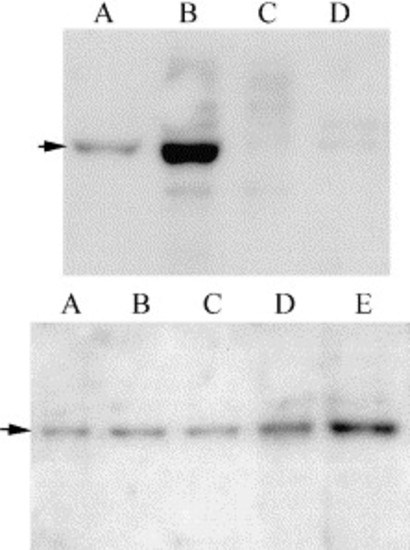Fig. 4
|
Detection and phosphorylation of phosphorylated FAK in zebrafish embryos. Co-immunoprecipitation and phosphorylation of FAK in Yes immunoprecipitates (upper panel) was detected by preparing immunoprecipitates from pooled membrane fractions (1000 embryos) collected 6 h postfertilization with either anti-Yes antibody at 5 μg/ml (A and B) or anti-Fyn3 antibody at 1 μg/ml (C and D). The immune complexes were washed and incubated in kinase buffer containing 50 μM Na3VO4 to suppress phosphatase activity. ATP was added to some samples at a final concentration of 100 μM (B and D) to initiate phosphorylation of FAK, and all samples were incubated at 25°C for 5 min, then heated in SDS-PAGE sample buffer to stop the reaction. Samples were resolved by SDS-PAGE and blotted to immobilon. Blocking solution for this experiment consisted of 5% BSA in TTBS containing 50 μM Na3VO4,, and the presence of FAK phosphorylated on Tyr 861 was detected using the anti-FAK[pY861] antibody at 0.5 μg/ml, followed by anti-rabbit-HRP, and chemiluminescence detection. The phosphorylated FAK is apparent as a single band indicated by the arrow. The phosphorylation of FAK at Tyr 861 in vivo (lower panel) was detected by Western blot analysis of pooled membrane fractions (50 μg protein) prepared at 2.5 hpf (A), 3.5 hpf (B), 4 hpf (C), 5.25 hpf (D), and 6.5 hpf (E). |
Reprinted from Developmental Biology, 277(1), Tsai, W.B., Zhang, X., Sharma, D., Wu, W., and Kinsey, W.H., Role of Yes kinase during early zebrafish development, 129-141, Copyright (2005) with permission from Elsevier. Full text @ Dev. Biol.

